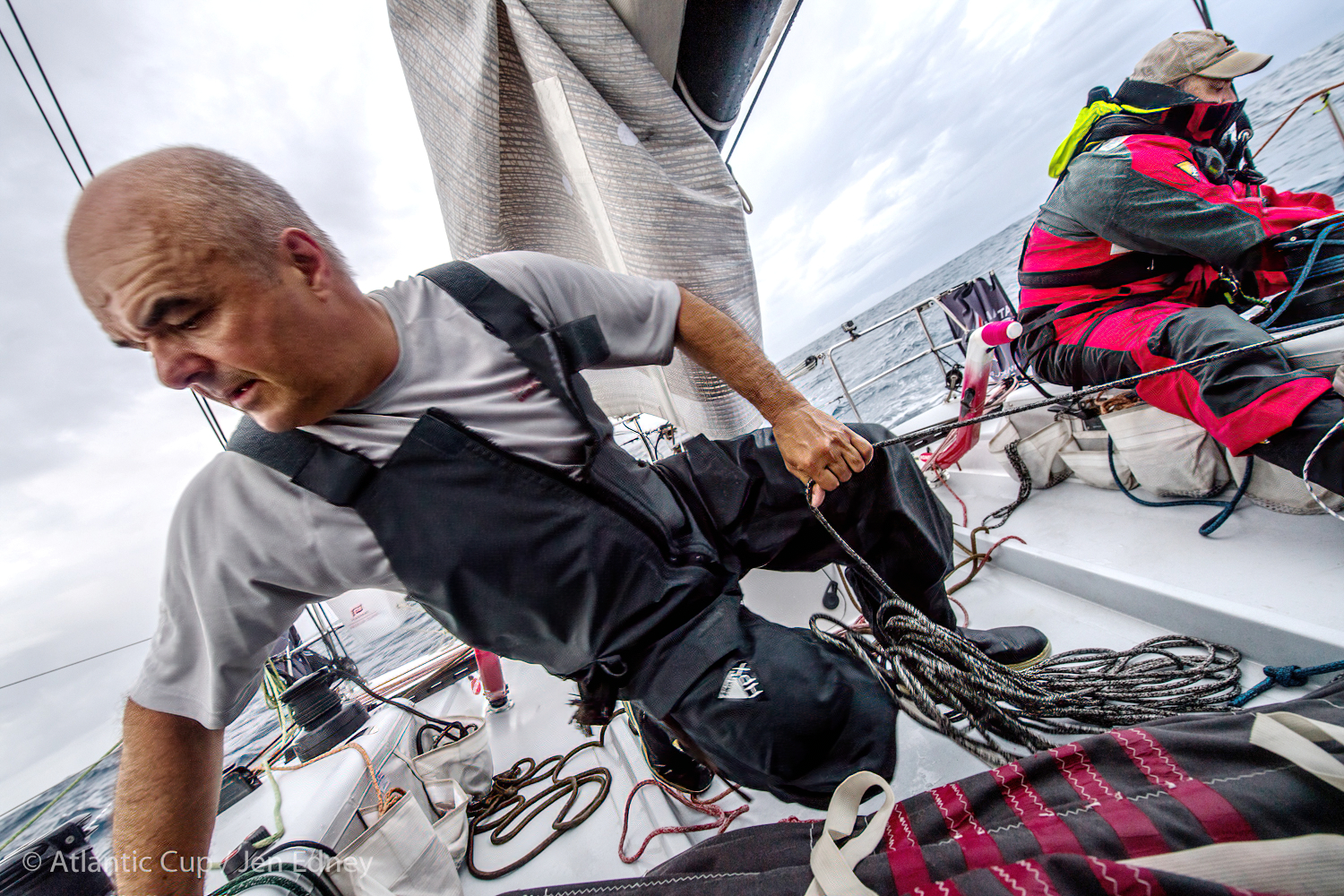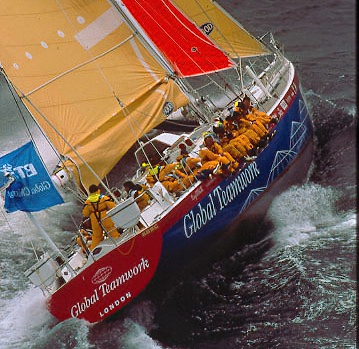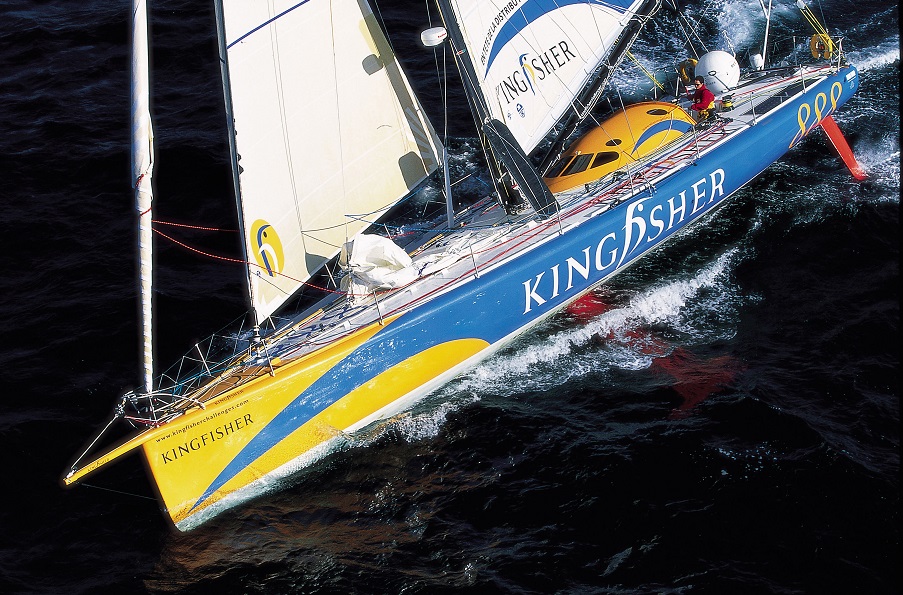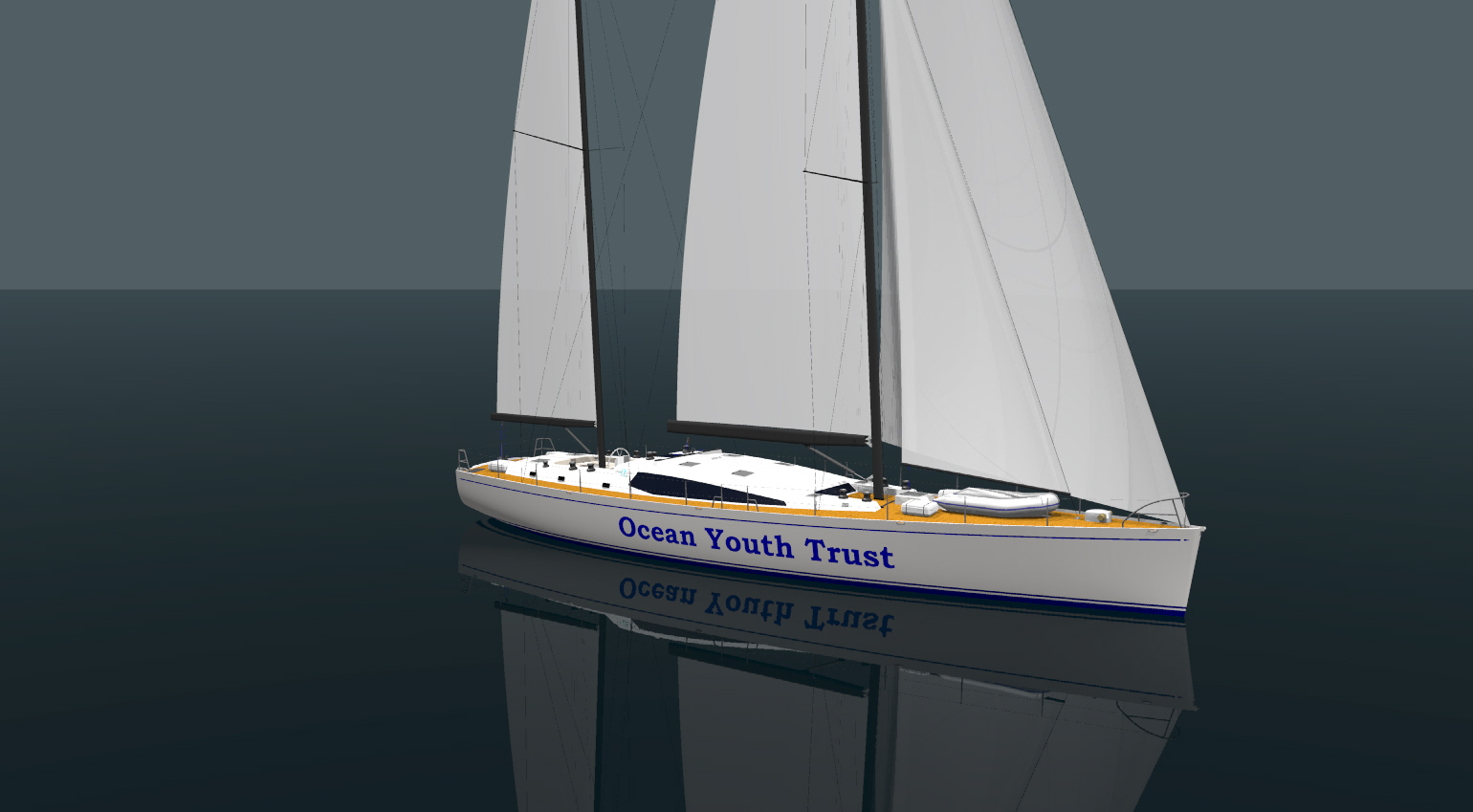Recently, Jane Vass from our Advisory Board was lucky enough to talk to Merf Owen, from Owen Clarke Designs. Merf is the inspirational ‘hands-on sailor-designer’ who started sailing with the UK based Ocean Youth Club. He’s been involved in the design and build of many legendary racing yachts, including Mike Golding’s Team Group 4 and Ellen MacArthur’s Kingfisher. He explains that the valuable life-skills he learnt as a young person during his early sail training voyages, helped him develop his successful career over the years.

Merf Owen in action
Hi Merf, it’s fair to say that you’ve had a pretty stellar career in a very high-tech, cutting edge field, but when our paths first crossed, it was in the sail training world. So what took you from there to here?
The first turning point was going sailing with the Ocean Youth Club. I come from the North of England, my family had no history of sailing, the closest to the sea I got was two uncles that served in the Royal Navy during the war. And that was it. But at school, I was offered three Outward Bound projects - climbing, canoeing and sailing. I’d decided that I was going to join the merchant navy, I wasn't going to carry on and do A levels. But I'd never been to sea apart from on a ferry, so I came down to Hamble where I live now, and went sailing with the Ocean Youth Club in 19 August 1979, the week of the Fastnet Race, in a woolly jumper and pair of jeans. I got very frightened, very cold, very wet. I loved it.
And so it all started from there. What were your next steps after that?
Pretty much straight after that summer I was in the Merchant Navy down in Plymouth and Falmouth Packet was the Ocean Youth Club boat down there. I became part of the support group, and because I had access to the college workshops and developed a certain amount of skills, I refitted Falmouth Packet for a couple of years.
While I was there I met Andy Brown, who skippered Grania, the first Ocean Youth Club boat in Northern Ireland. He instilled me with that passion for sailing in Northern Ireland, because very different kids were sailing there. And so I spent all my leave sailing with the Ocean Youth Club. I actually almost didn't go home for two years. Eventually in 1983 I came back from the sea, and I put myself through university to study engineering and naval architecture in London.
At that point I met the next person who made a big difference in my life, a fellow called Rupert Kidd who owned a very small trimaran, a 30-footer. He put an advert in a yachting magazine asking for a crew member to go racing with in the winter. And I signed up, we got on, we drove down to Lymington most weekends, we went winter series racing and I fell in love with multihulls.
While at university I decided that I would create what's called a velocity performance prediction (VPP) programme, which is a computer programme that predicts how a yacht sails and reacts to wind, as one didn't exist for multihulls at that time. I had some help from various people in the marine industry who were interested in the project, and developed this VPP as my final year project.
Rupert, meanwhile, had left his office job in London and was working as a geologist in Columbia. I got a phone call from him one day, and he said, you know, that boat we always talked about building. Well, I think I can afford it now. And if you can do it for this amount of money, you can design it. And I thought, well, yeah, that sounds like a great thing to do after I've left university. He flew in for a meeting in London and we met at Heathrow Airport and signed a contract to build a 35-foot trimaran, with a BA check-in clerk as the witness. It was as bizarre as that. And so with this contract in hand and a deposit, I went searching for places to build a boat and I ended up down in Looe in Cornwall.
One of the builders there was a fellow I knew called Allen Clarke. He’d done the boat building course at Falmouth and was a yacht design student now in Southampton. With a bunch of his friends, we built this boat from scratch, none of us actually having built a boat before. It was successful and came second in class in the 1988 OSTAR (single-handed trans-atlantic). It kind of snowballed from there.
In 1993 I was living in Plymouth and a friend of mine was doing a race called the Vendee Globe, a former multi-hull owner I’d met along the way. He was in the Southern Ocean on his own, miles from anywhere and the boat was rolled. He was very badly hurt, lucky to survive and he pulled into Hobart. He needed to get the boat home, so after he’d recovered he and I sailed this boat back, around Cape Horn to the States, and I got my first experience of short-handed, very long distance sailing. As I was rounding the Horn, I met a good friend of mine coming the other way, a fellow called Mike Golding. Of course, Mike had come second in the British Steel Challenge the year before. Mike convinced me over the radio that I should apply for Chay Blyth’s BT Global challenge coming up in a few years’ time. So, as we rounded Cape Horn, I contacted Chay Blyth by Satcom C and applied for the job. And when I arrived back, I found that I had been selected as a Skipper.

Global Teamwork on BT Global Challenge
You make it sound easy, but history is littered with people who've attempted to build one boat and get one venture off the ground!
In the end, I think it's all about people. Everything I’ve ever done that’s been worthwhile in my life has been with people. People like to work and do business and be in a team with good people. So the first thing is to be is to be is to be a good person, and to focus on something that you want in life and work towards it. From the age of 12 to 16, all I ever wanted to be was to put on a red jersey and play rugby for Wales - it was all consuming. That's what happened with sailing, and it all started with the Ocean Youth Club. It was so passionate. And I think if you're lucky enough to find something you're passionate about, and you focus and you’re good to people around you, then you attract good people who will help you.
I learned a lot of good people skills with the Ocean Youth Club. Sailing is great, but there are other things to learn. And with the Club, I'm sure I learned a lot about people, especially from really good skippers. They know how to talk to people, they know how to get the best out of people. And I learned how to do briefings, how to interact, how to do meetings and all those things you do every day with the Club. You don't think about it as learning, but you are learning. I know damn well, that when we built our first boat I didn't have great people skills, but I must have had some to be able to pull the team together.
I would add that what the club taught me and what I see that other sailors, sometimes, don't have, is seamanship. And if you want a career in the sailing industry, then sail training approaches things in a different way to say a sailing school. A sailing school teaches you yachting and the Ocean Youth Club taught me seamanship.
Did you know what you wanted to do next, when you came back from the BT Global Challenge?
I realised at the end of the BT global challenge that it was a bit like wanting to wear the red jersey for Wales, I wasn't a good enough sailor to make a living as a professional raceboat captain. So it was at that point that I decided that yacht design was probably the thing for me it, I enjoyed it, it's still let me go sailing and I still engage with people, which is something I love.
My very good friend Mike Golding had secured a sponsor to build an Open 60. So, I spent a year and half on his Team Group 4 campaign. The focus was first to do a race called the BOC Round the World,. After winning the first leg to Cape Town, he was sailing into New Zealand, leading overall by several days and unfortunately he ran aground and damaged the boat severely. We could potentially have started the next leg, but we couldn't be 100% certain about the integrity of the keel, so Mike pulled from the race at that point, which was an incredible shame because he would probably have won.

Kingfisher Open 60 going to windward
But other opportunities opened up. In particular, how did you come to be involved in Kingfisher?
Ah, Kingfisher, right. I met Ellen MacArthur during the BT Global Challenge, and I introduced her to Mark Turner, and they became business partners. So, here we go again, meeting people! Mark Turner had chartered the monohull that we designed in 1993, for the Round Britain later that year, but I hadn't seen him for seven years. Further down the path, Ellen I became boyfriend and girlfriend.
I had no intention to pitch for the design of Kingfisher at that point, because I was fully engaged with Mike’s campaign as his project manager. But that came to a halt when he grounded on the north end of New Zealand. I had had this idea that sometime in the future I would form a design team pulling together the best people that I knew in the industry. It just so happened that it came about four years earlier than I thought. Mike hitting the rocks gave me the option to be able to say to him, look, I'd like to go and do this.
So I put together this design team of different talents. I had the Open 60 experience, we had Andy Claughton for windtunnel testing, Rob Humphreys, a really good yacht designer on around the world boats, but who had never done a short-handed boat, and Giovanni Belgrano, a composites engineer par excellence.
The reality that I was Ellen's boyfriend at the time was a negative, not a positive, and it looked like we were going to lose the job because of this. I remember jumping in the car, and driving to the ferry terminal, because I knew they were they were down in France sailing. So I drove through the night, almost crashed the car, and had a good sit down with them. I managed to persuade them to bring in the design team approach. It was a complete plan. But really, it was one passionate approach at a meeting when pretty much we were down and out and we weren't going to get the job and then persevering. So I guess that's the lesson. Even when you think the last thing is done, it's not done.
There’s a huge range of boats in the Owen Clarke portfolio. What future challenges are you looking to?
We are always looking into the future. Our designs have always been from first principle, we didn't know really how to design and engineer a multihull when we started, but we just worked out how to do it. With the Open 60, we brought a new approach to it and we brought some new things into the class, never seen in it before. So all first principles.


Ocean Youth Trust sail training vessel design
We haven't finished racing boats, that's always about innovation, it's always about thinking of new things, new ways to solve problems but we are looking at cruising boats as well. Some years back we were asked by one of Ocean Youth Club’s successor organisations, OYT South, to design their new boat, but unfortunately after six years they were unable to raise funding to build her and bought Prolific instead. Last year, we were working on a hybrid powered motor sailor, for a Swiss-based polar research institute. We’ve had a recent inquiry for a hydrogen-powered fast cargo vessel of something like 9000 tonnes to transport hydrogen. And that's a completely new field for us, but its naval architecture, it’s working from first principles, and we won't do it on our own. We'll look around and we'll find the right people to work with. Teamwork, that's pretty much how we've always done it. No one has a monopoly on good ideas.
What do you think about the health of grassroots sailing? And does sail training really have a place today?
I really think it does, and not just in developing young people. When I was sailing on the Ocean Youth Club, I remember that maybe three out of the out of the 12 kids on the boat would come back. But it wasn't about those who came back to sail with a club, because you knew damn well, you had an effect on the other kids, they will have gone back to their schools, communities, with a different level of self-confidence, with a better ability to interact with other kids. You can't be shy on a 72-foot Robert Clark ketch! And I’ve seen this with adults - if you take everyone out of their comfort zone, then the ones who are the bullies, the ones who have confidence, then that personality doesn't exist anymore, and so it allows others to shine.
On the sailing side of things. I think it's really important that we take those 1, 2, 3 people out of a crew and create spaces for them, because worldwide the number of people going sailing is reducing and the prevalence of motorboats is going up. We need people who have the time, the money, and the will to invest in the skills to go sailing because anybody can drive a motorboat - to sail you need skill. And so, getting people interested in sailing is important for our sport and sail training organisations are obviously a big part of that.
And do you think it has a wider application for the wider marine industry?
Absolutely, I could name a lot of people I know who first went sailing or ended up as bosun or volunteer mates with the club, who are now yacht brokers, riggers, run race management companies - and they all learnt the ropes with sail training organisations.
A huge thank you to Merf for taking the time to talk to us.
